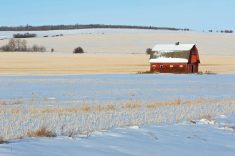U.S. wheat surged two per cent on Tuesday, with benchmark futures at the Kansas City Board of Trade climbing to the highest level in seven weeks on concerns scouts on an annual crop tour will find freeze-damaged fields in the top growing state of Kansas.
Corn and soybean futures each lost ground as investors at the Chicago Board of Trade (CBOT) took profits after Monday’s biggest rallies since last summer’s drought.
Wheat futures reversed from early losses to turn higher, capping their best month since July. KCBT’s most-active July contract rose 13-3/4 cents to $7.89-1/2 per bushel (all figures US$). CBOT July wheat gained 14-1/2 cents to $7.31, rising two per cent for the day and nearly five per cent for the month.
Read Also

U.S. livestock: CME cattle tick lower in thin pre-holiday trade
Chicago | Reuters – Chicago Mercantile Exchange live and feeder cattle futures were little changed but ended slightly lower on…
“Traders are hesitant to be sellers as they expect damage reports to come out of the crop tour. The crop tour is keeping sellers on the sidelines,” said Shawn McCambridge, analyst for Jefferies Bache.
The annual Wheat Quality Council tour started from Manhattan, in northeastern Kansas, with scouts finding wheat that is one to two weeks behind normal development and yield prospects slightly below last year.
Experts on the tour said crop conditions were likely to worsen as the tour moves west after cold weather stunted growth and damaged plants. Scouts stop overnight on Tuesday in Colby, in western Kansas near the Colorado border. The tour concludes on Thursday in Kansas City, where scouts will project yield and production for Kansas.
The U.S. Agriculture Department this week rated the winter wheat crop 33 per cent good to excellent, down from 64 per cent last year and the lowest for this time of year since 1996.
“You’re seeing the good stuff,” said Mark Hodges, executive director of Plains Grains, who is on the tour.
Corn slides
Corn futures shed 1.5 per cent and declined for the third straight month even as forecasts for snow and rains in the U.S. Midwest were likely to stall spring plantings that are already advancing at the slowest pace in history.
Futures for the yellow grain soared six per cent on Monday, rising the most since last July during the summer rally in which the worst drought since 1934 propelled corn and soybean prices to all-time highs.
Now, one of the wettest springs in history is delaying plantings but also replenishing soil moisture while growers are likely to respond to the historically high prices by increasing acreage. USDA in March estimated corn plantings as the biggest since 1933.
“Yesterday’s rally was overdone,” said Sterling Smith, a futures specialist for Citigroup.
CBOT July corn settled 9-3/4 cents lower at $6.50 per bushel, losing more than three per cent in the month.
Most-active July soybeans fell 10-3/4 cents to $13.99 but rose modestly during the month. Soybeans on a continuous chart jumped more than four per cent in April, for their best month since July.
U.S. farmers had planted only five per cent of the corn crop as of Sunday, matching 1984 for the slowest planting pace ever.
Heavy rains and as much as 30 cm of snow are forecast beginning on Tuesday, a meteorologist said.
“They (farmers) certainly won’t get much done this week. There is a big storm system starting Tuesday that will spread in intensity and coverage by Thursday and linger into the weekend,” said Don Keeney, a meteorologist for MDA Weather Services.
Keeney said snow could be expected from Nebraska, eastern Colorado, Kansas into the northern Midwest with up to a foot of snow possible in western Iowa. “Elsewhere they’ll receive heavy rains of two to three inches or more,” he said.
— Michael Hirtzer covers ag commodity markets for Reuters in Chicago. Additional reporting for Reuters by Sam Nelson in Chicago and Nigel Hunt in London.














